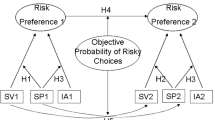Abstract
This study extends Xu and Reuf (Strateg Organ 2:331–355, 2004) by exploring the strategic and non-strategic risk-taking propensity perceptions of nascent entrepreneurs as it relates to the subsequent likelihood of venture formation success. In addition, the moderating influences of perceptions of environmental uncertainty and venture growth aspirations are also examined. Findings from an analysis of data from the Panel Study of Entrepreneurial Dynamics (PSED) I indicate that an entrepreneur’s risk-taking propensity has no relationship to the likelihood of successfully starting a business. Perceptions of environmental uncertainty and venture growth aspirations were positively related to non-strategic risk-taking propensity, yet none of these variables (strategic and non-strategic risk-taking propensity, environmental uncertainty and growth aspirations) had a significant effect on venture creation success. We suggest that risk-taking propensity, as measured in this study, does not play a significant role in differentiating between nascent entrepreneurs or others, or between those that are successful or unsuccessful at starting businesses.

Similar content being viewed by others
References
Acs, Z. J. (2008). Foundations of high impact entrepreneurship. Foundations and Trends in Entrepreneurship, 4(6), 535–620.
Autio, E. (2007). Global entrepreneurship monitor 2007 global report on high-growth entrepreneurship. London: London Business School; Babson Park, MA: Babson College.
Baron, R. M., & Kenny, D. A. (1986). The moderator-mediator variable distinction in social psychological research: Conceptual, strategic, and statistical considerations. Journal of Personality and Social Psychology, 51, 1173–1182.
Baum, R., Locke, E., & Smith, K. (2001). Multidimensional model of venture growth. Academy of Management Journal, 44(2), 292–303.
Cantillon, R. (1755/2001). Essay on the nature of commerce in general. New Brunswick, NJ: Transaction Publishers.
Carter, N. M., Gartner, W. B., Shaver, K. G., & Gatewood, E. J. (2003). The career reasons of nascent entrepreneurs. Journal of Business Venturing, 18(1), 13–39.
Delmar, F., & Shane, S. (2003). Does business planning facilitate the development of new ventures? Strategic Management Journal, 24(12), 1165–1185.
Gartner, W. B. (1985). A framework for describing and classifying the phenomenon of new venture creation. Academy of Management Review, 10(4), 696–706.
Gartner, W. B. (2008). Variations in entrepreneurship. Small Business Economics, 31, 351–361.
Gartner, W. B., & Liao, J. (2007). Pre-venture planning. In C. Moutray (Ed.), The small business economy for data year 2006: Report to the President (pp. 212–264). Washington, DC: U. S. Small Business Administration Office of Advocacy.
Gatewood, E. J., Shaver, K. G., & Gartner, W. B. (1995). A longitudinal study of cognitive factors influencing start-up behaviors and success at venture creation. Journal of Business Venturing, 10(5), 371–391.
Jackson, D. N. (1976). Personality inventory manual. Goshen, NY: Research Psychologists Press.
Jackson, D. B. (1994). Jackson personality inventory: Revised manual. Port Huron, MI: Sigma Assessment Systems.
Knight, F. H. (1921). Risk, uncertainty and profit. Boston, MA: Houghton Mifflin Company.
Lee, D. Y., & Tsang, E. W. K. (2002). The effects of entrepreneurial personality, background and network activities on venture growth. Journal of Management Studies, 38(4), 583–602.
Liao, J., & Gartner, W. B. (2006). The effects of pre-venture plan timing and perceived environmental uncertainty on the persistence of emerging firms. Small Business Economics, 27(1), 23–40.
Matthews, C. H., & Human, S. E. (2004). The economic and community context for entrepreneurship: Perceived environmental uncertainty. In W. B. Gartner, K. G. Shaver, N. M. Carter, & P. D. Reynolds (Eds.), Handbook of Entrepreneurial Dynamics (pp. 421–429). Thousand Oaks, CA: Sage Publications.
McGee, J. E., Peterson, M., Mueller, S. L., & Sequeira, J. M. (2009). Entrepreneurial self-efficacy: Refining the measure. Entrepreneurship Theory and Practice, 33(4), 965–988.
Milliken, F. (1987). Three types of uncertainty about environment: State, effect and response uncertainty. Academy of Management Review, 12, 133–143.
Miner, J. B. (1986). Scoring guide for the miner sentence completion scale—form T. Eugene, OR: Organizational Measurement Systems Press.
Miner, J. B., & Raju, N. S. (2004). Rick propensity differences between managers and entrepreneurs and between low- and high-growth entrepreneurs: A reply in a more conservative vein. Journal of Applied Psychology, 89(1), 3–13.
Reynolds, P., & Curtin, R. (2004). Appendix A. Data collection. In W. B. Gartner, K. G. Shaver, N. M. Carter, & P. D. Reynolds (Eds.), Handbook of Entrepreneurial Dynamics (pp. 453–476). Thousand Oaks, CA: Sage Publications.
Reynolds, P. D., Bygrave, W. D., Autio, E., Cox, L. W., & Hay, M. (2002). Global entrepreneurship monitor, 2002 executive report. Babson Park, MA: Babson College.
Sapienza, H. J., Autio, E., George, G., & Zahra, S. A. (2006). A capacities perspective on the effects of early internationalization on firm survival and growth. Academy of Management Review, 31(4), 914–933.
Sarasvathy, S. D. (2008). Effectuation: Elements of entrepreneurial expertise. Cheltenham: Edward Elgar.
Say, J. (1880/1971). A treatise on political economy: Or the production, distribution and consumption of wealth (C. R. Prinsep & C. C. Biddle, Trans.). New York, NY: Augustus M. Kelley.
Stewart, W. H., & Roth, P. L. (2001). Risk propensity differences between entrepreneurs and managers: A meta-analytic review. Journal of Applied Psychology, 86(1), 145–153.
Stewart, W. H., & Roth, P. L. (2004). Data quality affects meta-analytic conclusions: A response to Miner and Raju (2004) concerning entrepreneurial risk propensity. Journal of Applied Psychology, 89(1), 14–21.
Wicklund, J., & Shepherd, D. (2003). Aspiring for, and achieving growth: The moderating role of resources and opportunities. Journal of Management Studies, 40(8), 1919–1941.
Wu, B., & Knott, A. M. (2006). Entrepreneurial risk and market entry. Management Science, 52(9), 1315–1330.
Xu, H., & Reuf, M. (2004). The myth of the risk-tolerant entrepreneur. Strategic Organization, 2(4), 331–355.
Zhao, H., Seibert, S. E., & Lumpkin, G. T. (2010). The relationship of personality to entrepreneurial intentions and performance: A meta-analytic review. Journal of Management, 36(2), 381–404.
Author information
Authors and Affiliations
Corresponding author
Rights and permissions
About this article
Cite this article
Gartner, W., Liao, J. The effects of perceptions of risk, environmental uncertainty, and growth aspirations on new venture creation success. Small Bus Econ 39, 703–712 (2012). https://doi.org/10.1007/s11187-011-9356-1
Accepted:
Published:
Issue Date:
DOI: https://doi.org/10.1007/s11187-011-9356-1




